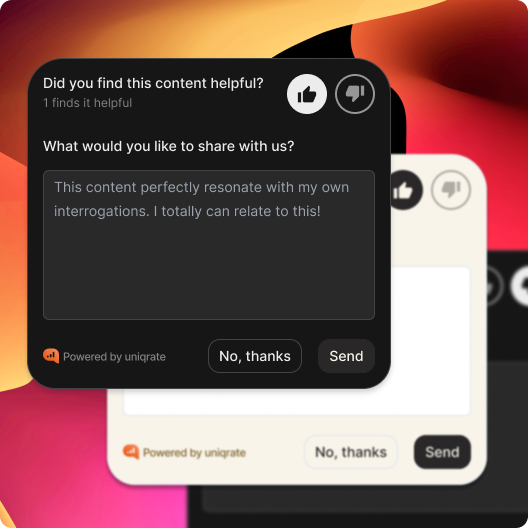User feedback is an invaluable asset for bloggers and technical writers looking to improve their content, engage readers, and drive results. By understanding what your audience values, struggles with, or enjoys, you can create better content, foster loyalty, and even turn readers into leads.
In this article, we’ll explore how to gather user feedback for your blog and how to leverage it to refine your strategy, increase engagement, and achieve your goals.
Why user feedback matters for your blog
User feedback goes beyond basic metrics like page views or bounce rates. It provides qualitative insights that reveal:
- What resonates: Understand which topics, formats, or styles your readers enjoy the most.
- What to improve: Identify gaps, unclear points, or underperforming posts.
- How to grow: Discover new content ideas or opportunities to expand your blog’s value.
For bloggers and technical writers, feedback can be the difference between guessing what works and knowing what engages your audience.
Types of feedback you can collect
Feedback comes in many forms, and each type provides unique insights. Here are some examples:
1. Content feedback
Learn what readers think about your blog posts. Do they find your articles helpful, engaging, or actionable? Content feedback helps you refine your writing and focus on what your audience values.
2. UX and design feedback
Understand how users interact with your blog’s layout, navigation, and functionality. Poor design or confusing elements can frustrate readers and lower engagement.
3. Topic suggestions
Readers often share what they want to learn more about. Their suggestions can inspire new articles or guide your content strategy.
4. Lead-generation insights
Feedback can also indicate how effective your blog is at driving conversions, such as newsletter signups or resource downloads.
How to collect user feedback for your blog
Here are effective strategies for gathering actionable feedback from your readers:
1. Use feedback tools
Platforms like Uniqrate provide interactive feedback islands that let readers:
- Vote on how helpful a post was.
- Leave comments with suggestions or questions.
- Engage by offering their email in exchange for a resource like a whitepaper or PDF.

2. Add comment sections
Encourage readers to share their thoughts directly on your blog. Prompt them with open-ended questions like:
- “Did this article answer your questions?”
- “What topics should we cover next?”
3. Conduct surveys
Use short surveys to ask readers about their preferences, challenges, and satisfaction with your blog. Tools like Google Forms or Typeform work well for this purpose.
4. Monitor social media
Readers often share their opinions or questions on social platforms. Keep an eye on comments, mentions, or messages related to your blog.
5. Send email follow-ups
If you have a mailing list, ask subscribers for feedback on your latest posts. This can help you refine your content and build stronger relationships with your audience.
How to use user feedback effectively
Collecting feedback is only the first step. The real value comes from analyzing and applying it to improve your blog.
1. Identify patterns
Look for recurring themes in your feedback. For example:
- Are readers consistently requesting a certain type of content?
- Do they frequently mention unclear sections or missing details?
These patterns can guide your improvements.
2. Optimize your content strategy
Use feedback to refine your approach to content creation:
- Focus on high-performing topics that resonate with readers.
- Experiment with new formats, such as videos or infographics, if suggested.
- Address gaps or common questions to provide more value.
3. Enhance user experience
Feedback about usability or design issues should be addressed promptly. Ensure your blog is easy to navigate, loads quickly, and works well on all devices.
4. Turn feedback into engagement
Show readers that you value their input by responding to comments, implementing suggestions, or creating content based on their ideas. When readers see their feedback in action, they’re more likely to stay engaged and loyal.
5. Capture and nurture leads
Use tools like Uniqrate to collect feedback and engage readers further by offering gated content in exchange for their email. This turns feedback into a lead-generation opportunity.
Benefits of using user feedback
By integrating user feedback into your blog strategy, you can achieve:
- Higher engagement: Tailored content and improved UX keep readers coming back.
- Better SEO: Engaged readers spend more time on your site, boosting search engine rankings.
- Increased loyalty: Acting on feedback builds trust and shows readers that you care.
- More leads: Feedback tools not only gather insights but also help you capture emails for future marketing efforts.
Conclusion
User feedback is an essential part of building a successful blog. By actively seeking and applying feedback, you can create a better experience for your readers, improve your content strategy, and drive engagement. Tools like Uniqrate make it easy to collect feedback and turn it into actionable insights, ensuring your blog remains relevant, valuable, and effective at achieving your goals.
Start gathering feedback with Uniqrate today and take your blog to the next level!
